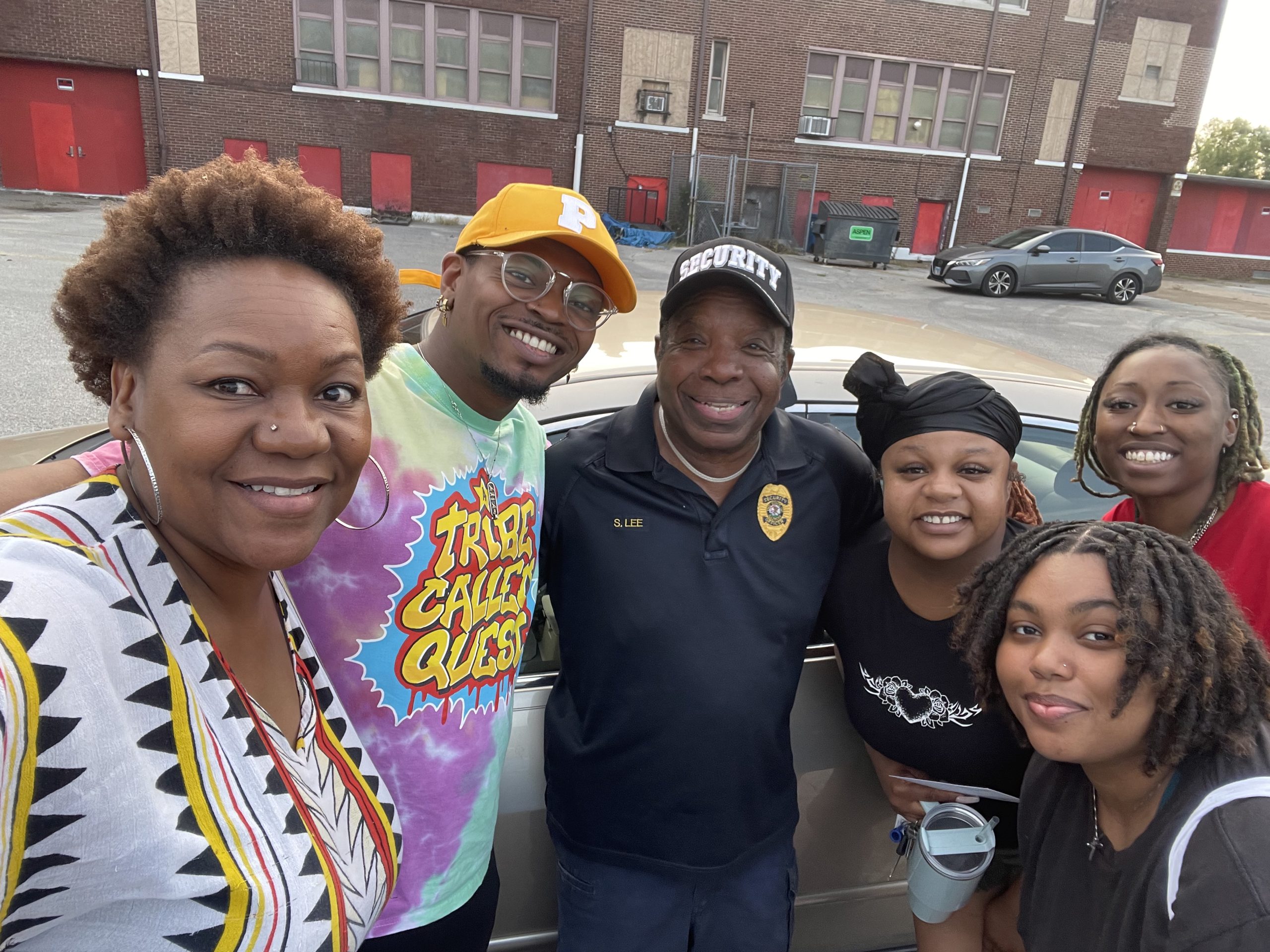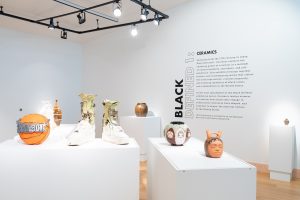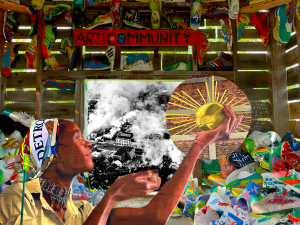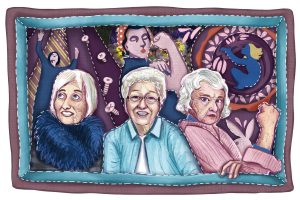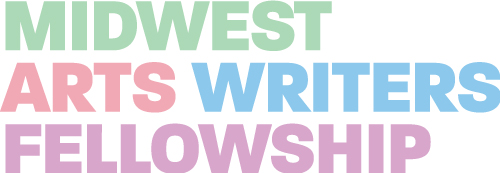
This essay is published as part of Sixty’s Midwest Arts Writers Fellowship, a 6-month opportunity for writers to develop, refine, and publish writings on topics that are relevant to Indigenous, trans, queer, diasporic, and/or disabled artists and arts workers in our region. Each Fellow will publish two essays that reflect on the complexities of Midwest life and the artists who help define and articulate its culture. Read more writing by the Fellows here.
If a movie about Sylvester “Sunshine” Lee’s life was made, it would open in 1992 with him chained to the federal building in New York City. Iconic comedian Dick Gregory flanks him on the left and his good friend Cleo Willis on the right. Each member of the trio engages the locks that chain them to the building, as a gaggle of press with boom mics and shoulder mounted cameras compete for a view. Six police cruisers pull up in rapid succession and a troop of New York City policemen exit the vehicles. They carry bolt cutters and roughly push through the press. Sunshine braces himself and looks at Dick Gregory. He whispers a conspiratorial “Aw shit. Here we go!”, and then shouts “Haitians are humans! Stop the racist policy against Haiti!” The policemen make quick work of their chains and hustle them to the waiting vehicles. In a crowded courtroom Sunshine stands in front of a judge, once again flanked by his comrades. The judge affirms their promise that they will not lock themselves to the federal building again. “Yes, your honor,” they each say. Sunshine is the last to speak.
In the scene’s final shot Sunshine’s fingers are crossed behind his back.
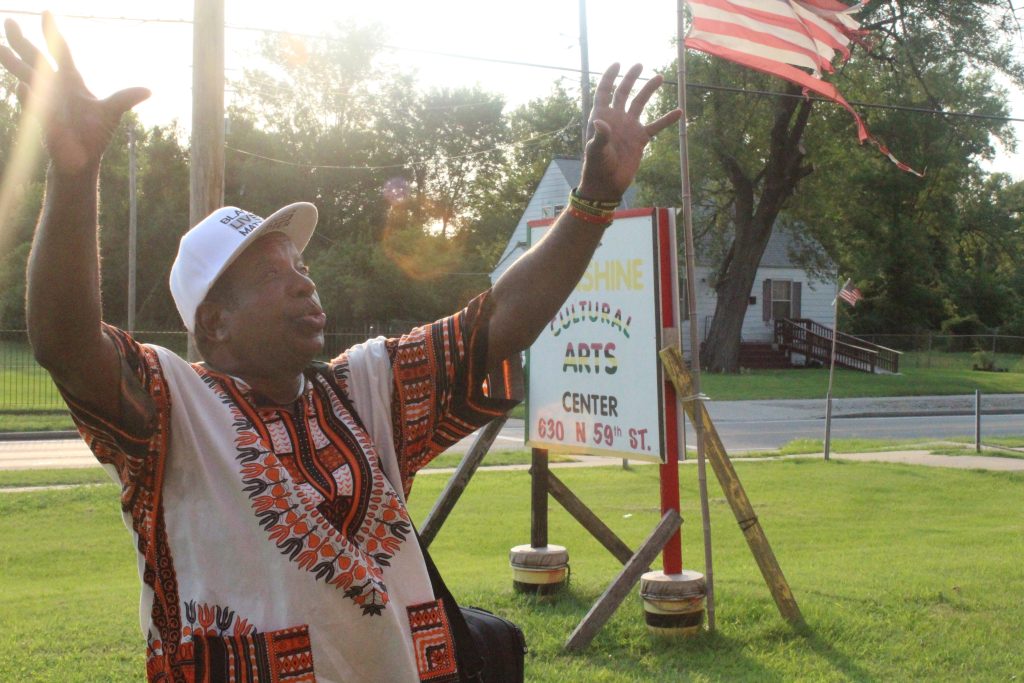
In 1992, Sylvester “Sunshine” Lee was arrested along with comedian and activist Dick Gregory, while protesting the U.S. government’s policy of denying Haitian immigrants entry. This was a protest in concert with his mentor, dance ethnographer, and cultural icon Katherine Dunham’s hunger strike to protest the same policy.
Dunham ended her hunger strike only after deposed president of Haiti, Jean-Bertrand Aristide, and Rev. Jesse Jackson visited her at home in East St. Louis, and entreated her to cease the strike.
According to the United Press International archives, Sunshine, Cleo Willis, and Dick Gregory were released on bond “after promising a federal judge they would not hold another protest within 100 feet of the federal courthouse,” where they had chained themselves to entrance doors.
Instead, they chained themselves “to the Social Security building a block away where federal marshals arrested them again.”
Why Sunshine, a master drummer and founder of The Sunshine Cultural Arts Center, would engage in this kind of daring civil disobedience on behalf of Haiti can only be understood through the lens of his upbringing in East St. Louis, Illinois; the city where he met Katherine Dunham and became a part of the Black Arts Movement.
If one were to think of the Black radical tradition as a timeline, the Black Arts Movement would overlap with the end of the Civil Rights movement and continue somewhere into the late 1970s, where some scholars use the beginning of Reagan‘s presidency and the ascendance of the conservative right to mark BAM’s end. Other scholars see Hip Hop as the artistic descendant of BAM, making 1976—hip-hop’s most agreed upon birth year—an ending point. In either case, the Black Arts Movement movement began in 1965 when poet Amiri Baraka founded and then situated the Black Arts Repertory Theater in Newark, New Jersey. BAM was marked by an intense, country wide, cultural and artistic output, which saw the notion of Black institution building and a reclamation of African ancestral arts as a key tenet. It took an oppositional stance to the Civil Rights Movement, jettisoning calls for integration in favor of Black Power, and (riffing on W.E.B. Dubois) proclaimed that Black art should be for us, by us, about us, and near us. East St. Louis, Illinois is one of the radical heartbeats of the Midwest, an often overlooked bastion of the Black Arts Movement. Although after several decades of industrial abandonment, population loss, and the rise of the illegal economy (with its attendant violence), one could argue that the city is in cardiac arrest.
In Never Been a Time: The 1917 Race Riot That Sparked the Civil Rights Movement, Harper Barnes writes,
“The population of East St. Louis hit its peak of 82,000 in 1950, when the city was still predominantly white. The tipping point—when Blacks began to outnumber whites—came in the very early 1960s, and the departure of whites became a panicked exodus. By 1970, the total population had fallen to 70,000, about 70% Black” (242).
Barnes’ book uses East St. Louis’s 1917 race riot—a racially motivated three day killing spree that resulted in hundreds of Black residents’ deaths and thousands displaced—as a locus for the growth of national civil rights organizations like the NAACP. Indeed, one of the NAACP’s founders—W.E.B. Dubois—came to the city following the riots to cover it for the NAACP’s Crisis magazine.
According to the most recent U.S. Census conducted in 2020, East St. Louis’s current population stands at 18,469 souls.
By 1967 (exactly 50 years after the 1917 pogrom), East St. Louis played host to another racial war. This time the death of a young Black man at the hands of police precipitated the violence that ensued. Unlike the 1917 riots, that young man remained the only fatality. But in both instances, East St. Louis’s unresolved racial hierarchies had once again simmered to a boil and resulted in Black death.
Just two years later, CBS news broadcast its special report, “The Battle For East St. Louis”, in which the host, Hughes Rudd said “Unemployment, especially among Blacks, rose sharply. So did anger. By the spring of 1969 East St. Louis was a riot waiting to start.“
Sunshine locates the downturn in East St. Louis’s fortunes to around that time, 1970—the year after he graduated from high school.
“When we got our first Black mayor, white folks began to leave and take their businesses elsewhere. That was the downfall. These vacant buildings used to be businesses [where] our mothers [and] fathers used to work. There always was a place to work and there always was a place to go. We had family doctors that we went to. Now they’re gone.”
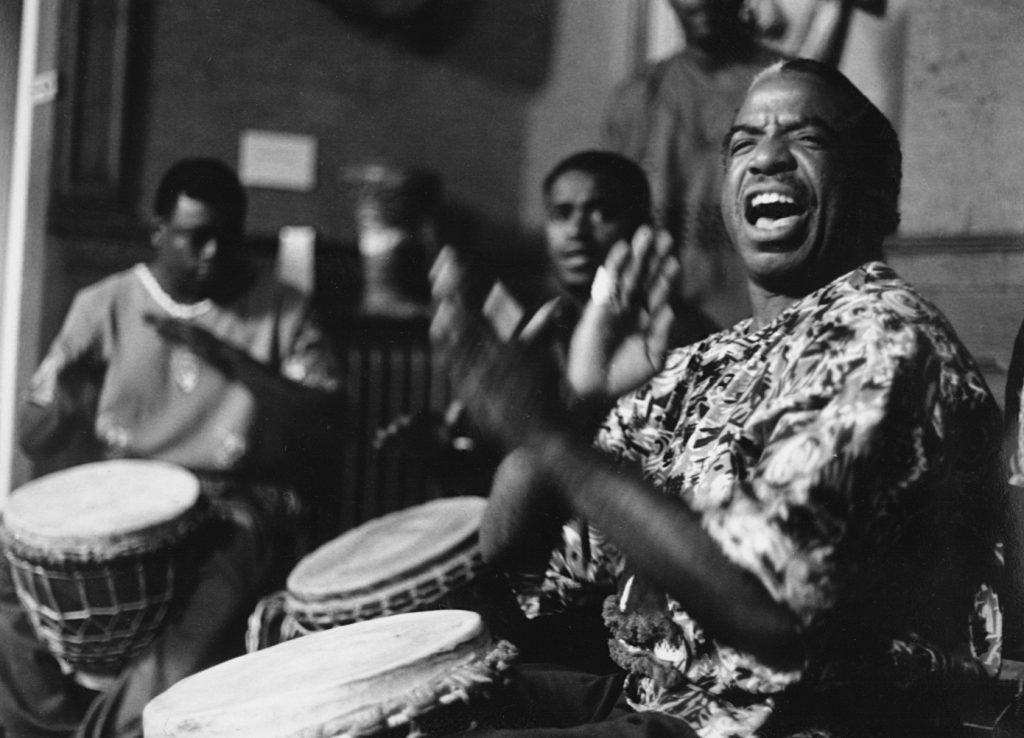
When speaking with Sunshine about his childhood and path to the arts, he says, “I was not a painter. Rapping wasn’t a part of that period growing up anyway. I wasn’t even a drummer. I didn’t start drumming until I was like 16 years of age when I started hanging with Arthur Moore.” Sunshine told me how he and Arthur won the Lincoln High School talent show. Arthur served as Danny Ray to Sunshine’s costumed James Brown; as Sunshine threw off his stage cape and landed an impressive split. Moore led Sunshine to the Katherine Dunham Performing Arts Training Center, which offered high school credit toward graduation. Sunshine graduated with the help of credits from the PATC in 1969.
In addition to the social conditions of the city, there was the Vietnam War draft. Sunshine doesn’t know why his name never appeared on the draft board lists, but a significant swath of his age mates served and died in Vietnam, far from their home in East Saint Louis. Sunshine, however, is quick to clarify that he would not have gone to Vietnam even if he had been drafted. He was philosophically opposed to the war like one of his idols, Muhammed Ali.
Sunshine came of age in a minefield, and to add to that he was a teen father. He welcomed his first child while still a senior in high school.
Though he was raised in the Black church, the son of a Baptist minister, Sunshine doesn’t describe his political development as a move from Christian, integrationist philosophy to Black Power. He describes himself as an early adopter of Black Power, reminiscing “No, I would say I got straight to the revolutionary.” Sunshine recognizes the Black Panthers, and local gangs like the Black Egyptians and the War Lords, emerged as a result of the political demands and material needs of the time. The gangs were an answer to deepening inequality, structural racism, and how both bar entire communities from federal and state resources and economies. When asked if he was a member of any of the gangs, he chuckles, “I had a brother. He kept me out of a lot.”
In addition to graduating, 1969 is also the year Sunshine met Katherine Dunham. Of Dunham, Sunshine’s friend Arthur told him, “Man, this woman done been everywhere!” Arthur was not exaggerating. Katherine Dunham had gone to the Caribbean to study the region’s dances and had become a Vodun initiate during her study. She was one of the first Black women to earn a graduate degree from the University of Chicago, and had published a book, Island Possessed. Dunham choreographed for Hollywood films and traveled extensively with her own African American touring company. She owned homes in Haiti, Senegal, and France. In 1967, in response to the widespread disenfranchisement of East St. Louis’ African American children, Dunham used her position as an artist in residence at Southern Illinois University to open a performing arts and training center in the city. She endeared herself to the city’s youth by being arrested with them in protest of the city’s discriminatory hiring and policing. Sunshine describes her presence as “breathtaking.”
“She came into the room and things got very quiet.” Sunshine recalls sitting on Dunham’s studio floor, while she sat on a seat and spoke to him and the other novice drummers and dancers. He adds “to this day I do the same thing” in his own studio, which he’s led for forty-six years.
Sunshine became an integral a part of the Black Arts Movement in East St. Louis; joining the region’s artistic answer to the Black Power movement.
While, the Black Egyptians used civil disobedience, and even explosives to disrupt the oppressive systems in East St. Louis and assert Black Power. Katherine Dunham subverted those same systems through emboldening the self image of young people like Lee, to whom she gave the name “Sunshine” because of his smile and his inner light. Through Dunham, Sunshine got an opportunity to sit at the feet of master drummers from Senegal, like Mor Thiam, and to become a master drummer in his own right.
After graduating, Sunshine married his high school sweetheart. The same older brother who kept him out of gangs, helped him get a job at the Urban League, another organization whose roots were watered by the 1917 riots. During this time he kept drumming under Dunham’s teachings and kept observing how a successful arts organization was run.
After almost a decade with Dunham, Sunshine received her blessing to start his own company, The Sunshine Cultural Arts Center (SCAC).
He recalls the day in 1978 when he went to Dunham’s stately home on 10th street. By then Dunham had put some distance between herself and the world; she used her assistant Janelle as a firewall against any visitors, neighbors, former students, fans, the public, anyone who might waste her time. Sunshine explains, “I did something very unusual. Janelle opened the door. I stuck my feet in the door and I said I’m not leaving. When I told Katherine Dunham what I was going to do I had already had my mind set, and I just wanted to tell her.”
By then Sunshine had three children (a daughter and two sons) and two jobs. In addition to the Urban League, he worked as a community organizer at Lessie Bates Davis Neighborhood House. Lessie Bates allowed him to hold classes in their basement, and Sunshine’s supervisor from the Urban League drew up his nonprofit paperwork.
Sunshine began integrating his working life, family responsibilities, and the day to day duties of running a high performing arts nonprofit.
During the day, Sunshine excelled at securing employment for Black residents through his Urban League position. In the evening, he taught many of East St. Louis’s children drumming. Eventually he added African dance to the repertoire and cultivated a no drugs and no fraternizing policy. Sunshine earned the trust of the community. In the early 1980’s he leveraged that trust to broker an unprecedented meeting between disparate factions and gangs in the city, continuing Dunham’s legacy of radicalizing street gangs. “I was working for the Urban League. They [gang members] knew me cause I was teaching dance. I had a meeting at St. Mark’s church, and I brought them all together. They vowed to stop some of the violence against each other, and we ended the evening having a banquet style meal.”
It wasn’t long before SCAC secured its first dedicated space on 14th street at the former Gym Center. Sunshine explains, “The Presbyterians were leaving the city and they gave it to the Red Cross.” The Red Cross gave it to Sunshine. “That’s how I left Lessie Bates’ basement.” Sunshine tapped into East St. Louis’s original cadre of religious philanthropic city funders—settlement houses like Lessie Bates, well heeled Christian denominations like the Presbyterians, and the Red Cross with its deeply Calvinist roots.
Present day East St. Louis is marked by what some may call the nonprofit industrial complex, which is often times well meaning, while at other times paternalistic and missionary. When industrial jobs which once were the norm in the city became a rarity, charitable organizations, religious organizations, and philanthropic nonprofits filled in gaps in services left by a diminished tax base. At the same time, the nature of nonprofits is to provide grant funded short term/project based employment. Meaning that the organizations can not provide enough opportunities for consistent well paying employment to match the need in East St. Louis, despite the number of nonprofits that claim addresses in the city. A basic Google search of “nonprofits in East St. Louis, Illinois,“ yields around 24 distinct organizations, and if one searches with the same query, substituting “churches” for nonprofits, the first page reveals 38 distinct congregations, with more searches on subsequent pages.
As a bootstrapping, new not for profit arts organization, The Sunshine Cultural Arts Center made repairs to the declining building once occupied by Presbyterians, beautifying it for their incoming students. When representatives from the Presbyterians came to see a performance they were blown away. “They gave me a $10,000 check to finish my work. That was a blessed day,” Sunshine says.
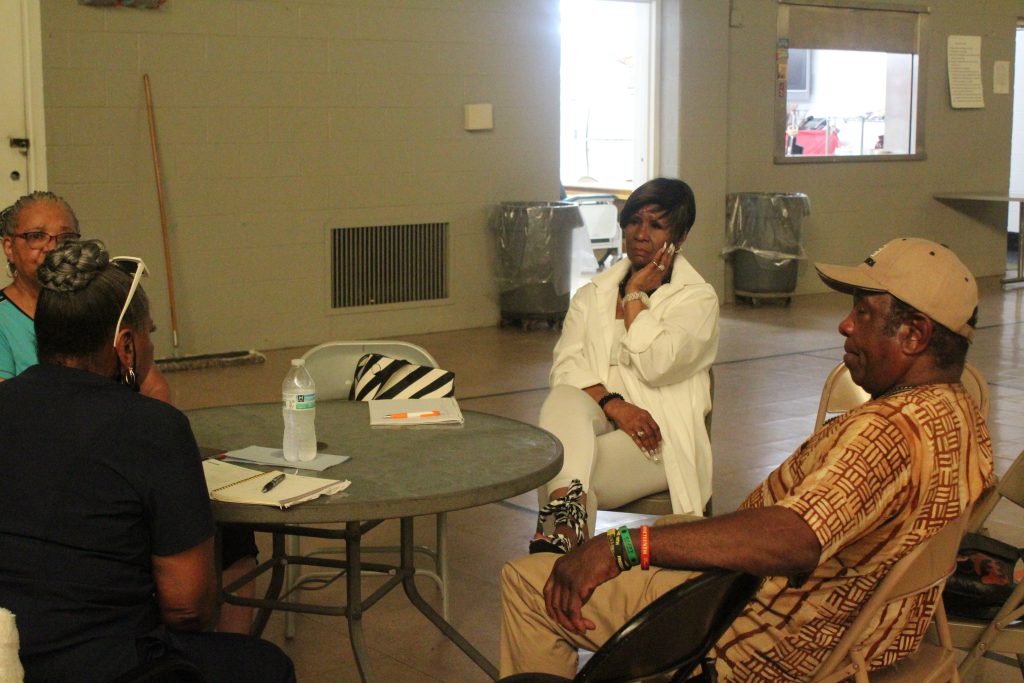
The 1990s were a decade bookended by personal and communal loss. In 1992, Sunshine’s oldest daughter was shot and killed during a home invasion in nearby Washington Park, Illinois. In 1998, Sunshine’s alma mater, Lincoln High School was closed due to population loss. The high school that had served the city’s Black residents since the 1800s, and boasted graduates like Miles Davis, was consolidated with what had been the white high school, East St. Louis Senior High.
Eugene Redmond, East St. Louis’s Poet Laureate since 1976 says “people have died, people have gotten killed, people have OD’d. Sunshine went through that.” Redmond, who was close with Dunham, briefly serving as her tour manager in the 1960’s, has known Sunshine since he was a teen. “He’s insinuated what he’s doing into the community in a way that nobody has with any kind of durability.” Redmond recalls a recent experience at a community festival, where a former student of his who had earned a PhD, approached him to share that she had first heard him read poetry at SCAC. Sunshine calls Redmond a mentor and “big brother.”
Redmond says the secret to Sunshine’s long standing is that he is “Home grown [and] home embedded.” He adds, “and once he sees somebody looking at a little girl’s ass he gets rid of them. He’s been very pure that way. No drugs, no alcohol. He has a Muslim ethic.”
SCAC has offered (in addition to the constant drumming and dance classes), sewing, a gym, a midnight basketball league, a computer lab, a food pantry; and annual gatherings like its Kwanzaa celebration, children’s bicycle giveaways, and clothing giveaways. Sunshine’s response to East St. Louis’s institutional needs has been to fulfill them and the above is not an exhaustive list.
East St. Louis’s response to Sunshine has been to love him back. When the staff at The Monitor learned about Sunshine’s 2007 cancer diagnosis, he recalls the front page of the paper reading, “Sunshine Needs Sunshine Love,” alongside a city-wide call for support. A packed event, part fundraiser and part celebration, was held at Blackmon’s Plaza in downtown East St. Louis.
“The mayor, Gordon Bush, gave me a lifetime achievement award. People showed up. That was love that brought me up.”
Since 2012, SCAC has occupied the former William Morrison grade school, at 630 North 59th Street. Morrison originally did not allow Black children to occupy the building. Today it is filled with them almost every weekday afternoon.
When asked why he never left, Sunshine answers, “My children.” His two sons remain in the area, as does his youngest daughter, Tynetta Lee, who is a principal dancer and choreographer. His children also refers to the hundreds, maybe even thousands of children he has taught, mentored, and traveled with as far as Africa.
East St. Louis or “East Boogie”, as it was affectionately named in the 1960s because of its booming nightlife and reputation for talented musicians, is like many of the places that grow you until you have enough good sense to leave. This is a common narrative in the U.S. Especially for artists. Former residents like Miles Davis and Ike and Tina Turner “make it big” and never return, or only return to receive the key to the city or have a school named after them. This, for artists, is one version of the “American Dream.”
We watch these “success stories” as they are interviewed about their early lives and they mention the teachers who shaped them. The teachers who gave them just enough to leave, and start a real career.
Sunshine could be an avatar for so many sweet high school English teachers, or piano teachers, or local dance teachers in small towns who stand in the background misty-eyed as the camera zooms in for a close-up on someone really famous as they say, “I couldn’t have done it without you.” Sunshine could be that avatar if it wasn’t for the fact that The Sunshine Cultural Arts Center is more than a typical hometown studio. SCAC is not a place where mostly middle-class kids go to check an activity box. What Sunshine has created in a systematically disenfranchised city, is a consistent community touchstone, where generations of East St. Louis residents have received world class arts training.
More than four decades after founding The Sunshine Cultural Arts Center, he and East St. Louis continue to choose each other everyday. Sunshine says, “[The community] relies on my center. It’s been 46 years now, and I’m not feeling tired.”
* * *
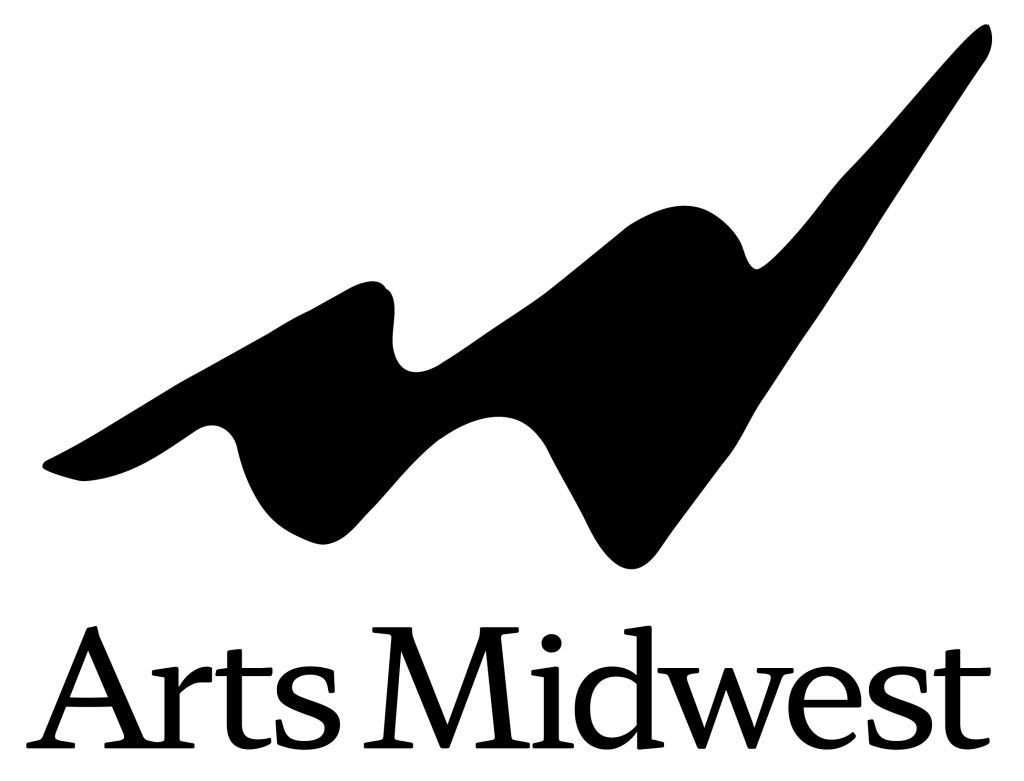
This fellowship is made possible with support from Arts Midwest. Arts Midwest supports, informs, and celebrates Midwestern creativity. They build community and opportunity across Illinois, Indiana, Iowa, Michigan, Minnesota, North Dakota, Ohio, South Dakota, Wisconsin, the Native Nations that share this geography, and beyond. As one of six nonprofit United States Regional Arts Organizations, Arts Midwest works to strengthen local arts and culture efforts in partnership with the National Endowment for the Arts, state agencies, private funders, and many others. Learn more at artsmidwest.org.
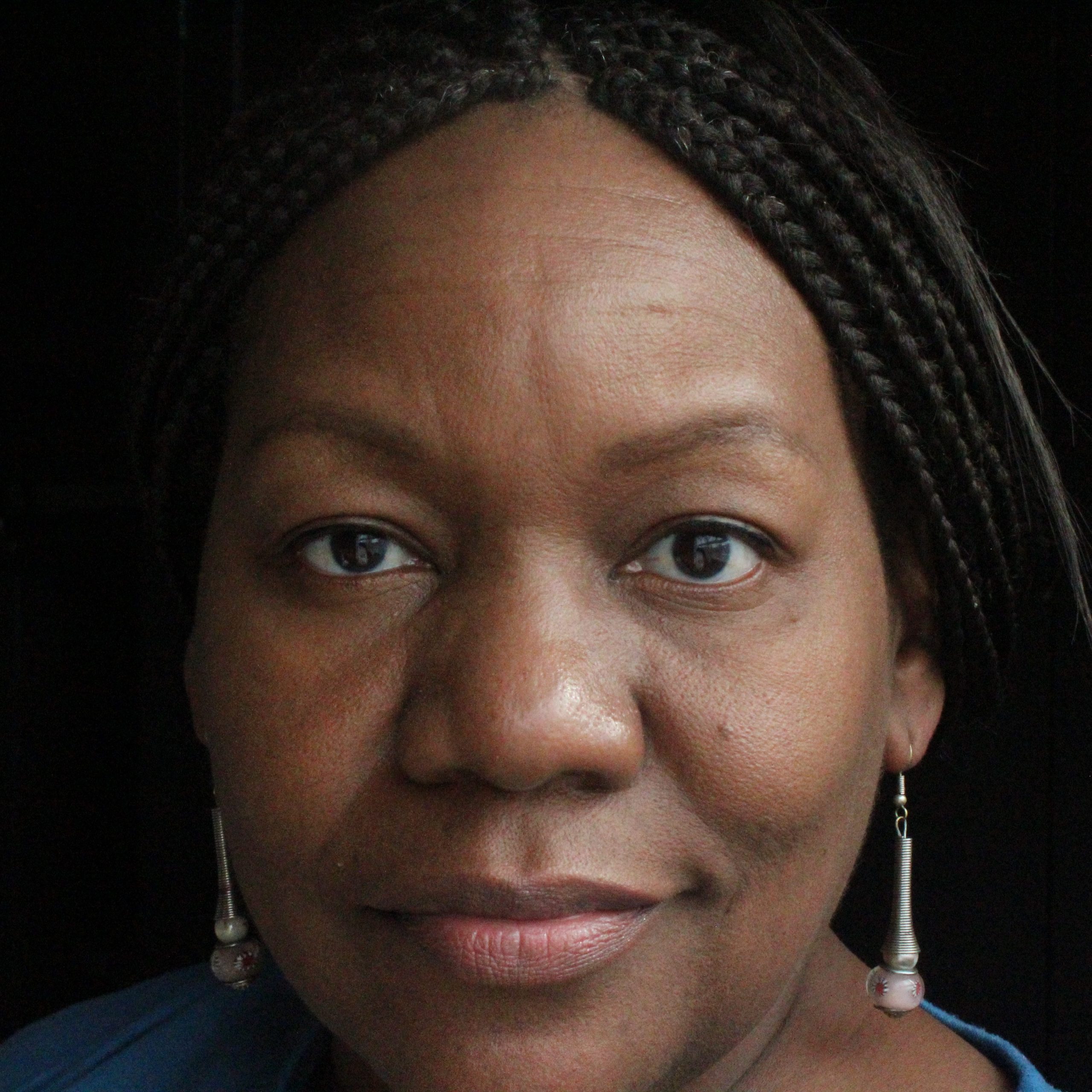
About the author: Dr. Treasure Shields Redmond is a dual citizen of Meridian, Mississippi and East St. Louis, Illinois. She is a published poet, master educator, community arts organizer, and culture keeper. As a teen, she was signed to M.C. Hammer’s label as a hip hop artist and writer. She is the author of chop: a collection of kwansabas for fannie lou hamer (2015) and is the co-founder of Fannie Lou Hamer House, an artist’s retreat located in Illinois. Dr. Shields Remond is also the founder of The Community Archive, a non profit where she teaches communities how to collect their elders’ oral histories. Treasure’s work centers East St. Louis, Illinois, an all Black township on the eastern banks of the Mississippi river. Through the story of the Sunshine Cultural Arts Center, and its founder Sylvester “Sunshine” Lee, Treasure explores how arts institutions can be a model of community care in the ”rust belt.”
